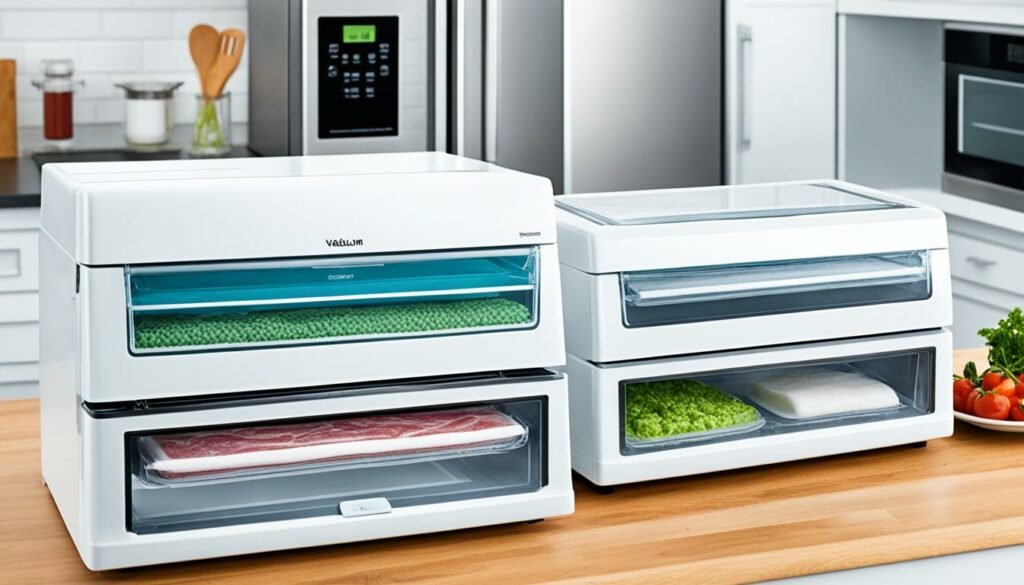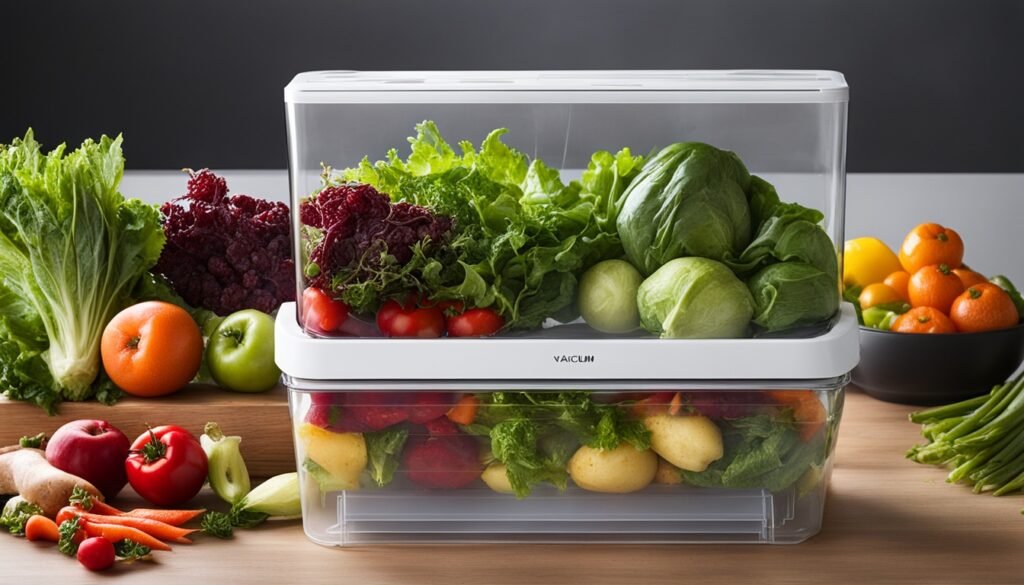I’ve always been intrigued by the art of food preservation. Techniques like vacuum sealing and freezing are essential for maintaining food freshness. This article will explore the cost-effectiveness of these methods, guiding you in selecting the ideal option for your kitchen.
Both vacuum sealing and freezing aim to prolong food shelf life through different mechanisms. Vacuum sealing eliminates air from packaging, while freezing hinders bacterial growth. We will examine their initial costs, long-term savings, and effects on food quality.
To assist you in making an informed choice, we’ll dissect the costs and advantages of vacuum sealing and freezing. By the conclusion of this piece, you’ll grasp which method aligns with your budget and lifestyle preferences.
Understanding Vacuum Sealing and Freezing Methods
Preserving food is essential for saving money and cutting down on waste. I’ll delve into two effective methods: vacuum sealing and traditional freezing. Both approaches extend shelf life and keep food quality high.
What is vacuum sealing?
Vacuum sealing removes air from packaging to preserve food. A vacuum sealer seals tightly, preventing freezer burn and oxidation. This method can keep food fresh up to five times longer than usual.
Traditional freezing techniques
Traditional freezing stores food in containers or bags at low temperatures. It slows down bacterial growth and enzymatic reactions, keeping food quality for longer.
Benefits of both methods for food preservation
Vacuum sealing and freezing bring numerous benefits to food storage:
- Extended shelf life
- Maintained food quality
- Reduced food waste
- Cost savings on groceries
| Method | Shelf Life Extension | Equipment Needed | Best For |
|---|---|---|---|
| Vacuum Sealing | 3-5 times longer | Vacuum sealer, bags | Meats, cheese, dry goods |
| Traditional Freezing | 6-12 months | Freezer bags, containers | Fruits, vegetables, leftovers |
Understanding these methods helps me make better choices for food storage. This way, I can extend the life of my groceries.
Initial Investment: Equipment and Supplies
Exploring food preservation methods reveals the importance of understanding initial costs. Both vacuum sealing and freezing demand an upfront investment in equipment and supplies.
Vacuum Sealer Cost and Accessories
Vacuum sealers vary in price, starting at around $20 for budget-friendly models and reaching up to $400 for high-end options. Quality sealers typically fall between $100-$200. It’s crucial to consider the additional cost of vacuum sealer bags and rolls, vital for food storage.
Freezer Bags and Containers
Freezer bags and containers are more budget-friendly at the outset. A box of freezer bags costs approximately $5-$10, depending on the brand and quantity. Reusable containers, though pricier, average $15-$30 for a set.
Long-term Cost Considerations
Assessing the vacuum sealer cost versus the freezer cost requires a look at long-term factors. Energy usage, bag replacement frequency, and potential food waste reduction are key considerations. Many vacuum sealers come with warranties, providing assurance for your investment.
| Method | Initial Cost | Ongoing Expenses | Potential Savings |
|---|---|---|---|
| Vacuum Sealing | $100-$200 | Bags, energy | High (less food waste) |
| Freezing | $5-$30 | Bags, containers, energy | Moderate |
Cost Comparison: Vacuum Sealing and Freezing
Exploring the costs of preserving food through vacuum sealing and freezing reveals both methods have their strengths and weaknesses. Let’s examine the cost-effectiveness of these two approaches.

Vacuum sealing demands an initial investment in equipment. A high-quality sealer can range from $50 to $200. Additionally, you’ll need to purchase bags, which are priced between $0.50 to $1 each. Although the initial cost may seem high, it often leads to long-term savings.
Freezing, conversely, offers a lower entry point. You might already possess a freezer, and basic bags are quite affordable. Yet, these bags do not shield against freezer burn as effectively as vacuum-sealed alternatives.
Let’s dissect the costs through a detailed comparison:
| Method | Initial Cost | Ongoing Costs | Food Waste Reduction |
|---|---|---|---|
| Vacuum Sealing | $150 (average sealer) | $0.75 per bag | High |
| Freezing | $0 (assuming you have a freezer) | $0.10 per bag | Moderate |
Vacuum sealing, despite its higher initial costs, stands out for its effectiveness in reducing food waste. This can result in significant savings, particularly when purchasing in bulk. Freezing might appear more economical at first glance, but it’s crucial to evaluate the long-term benefits when comparing these preservation techniques.
Efficiency and Food Waste Reduction
Vacuum sealing and freezing techniques have transformed my kitchen’s efficiency and grocery budget. These methods are pivotal for reducing food waste and ensuring long-term food storage.
Extending Shelf Life
Vacuum sealing is a game-changer for food preservation. It extends the shelf life of foods by up to five times, compared to traditional storage. This means less spoilage and a notable decrease in food waste.

Combating Freezer Burn
Freezer burn is a common issue when freezing food. However, vacuum sealing effectively removes air from the packaging. This method preserves food quality, allowing for bulk grocery savings and more efficient meal planning.
Budget-Friendly Bulk Purchases
Longer food storage capabilities enable smart shopping. I can now capitalize on sales and seasonal produce without worrying about waste. This approach has significantly reduced my food budget.
| Storage Method | Shelf Life Extension | Freezer Burn Prevention | Bulk Purchase Potential |
|---|---|---|---|
| Vacuum Sealing | 3-5 times longer | Excellent | High |
| Traditional Freezing | 1-2 times longer | Moderate | Moderate |
Adopting these storage techniques has revolutionized my grocery shopping and meal prep. The combination of reduced food waste, extended storage, and bulk purchasing has led to significant savings and a more organized kitchen.
Conclusion
After examining the pros and cons of vacuum sealing and freezing, it’s evident that each method has its unique benefits for preserving food affordably. Vacuum sealing stands out for maintaining food quality and extending its shelf life. This can result in substantial savings, particularly for bulk buyers or large families.
Freezing, however, offers lower initial costs and is a familiar approach for many. Yet, it’s important to acknowledge the risk of freezer burn, which could lead to increased food waste when compared to vacuum sealing.
The decision between vacuum sealing and freezing hinges on individual needs and routines. It’s advisable to assess your shopping habits, storage capacity, and goals for food preservation. This thorough evaluation will guide you in selecting the most suitable option for your lifestyle and financial planning.
FAQ
What is the cost difference between vacuum sealers and freezers?
Vacuum sealers can cost between and 0, with most quality models priced between 0-0. You’ll also need to budget for vacuum sealer bags and rolls. On the other hand, traditional upright or chest freezers are generally cheaper upfront compared to vacuum sealers.
How do vacuum sealing and freezing extend food shelf life?
Vacuum sealing removes oxygen from food, creating a seal that stops freezer burn and oxidation. This method keeps food fresh 3-5 times longer than regular packaging. Freezing, by slowing down bacterial growth and enzymatic reactions, also extends shelf life significantly.
What are the long-term cost considerations for vacuum sealing and freezing?
Long-term costs include energy use, bag or container replacement, and reducing food waste. Vacuum sealers use electricity when in use, while freezers run continuously. Yet, vacuum sealing can save money over time by cutting down on food waste and allowing bulk purchases.
How can vacuum sealing and freezing impact grocery budgets?
Vacuum sealing extends food shelf life, making bulk purchases possible and cutting down on grocery trips. This can lead to lower food expenses. Freezing also reduces waste but might not keep food quality as long as vacuum sealing. Both methods help preserve seasonal produce and prep meals, making grocery budgeting more efficient.
Which method is more cost-effective for food preservation?
The cost-effectiveness varies based on individual needs and habits. Vacuum sealing provides better preservation and can save money over time but requires a bigger upfront investment. Traditional freezing is cheaper initially but might result in more waste. Consider your food storage needs, budget for equipment, and long-term storage requirements when choosing between these methods.
